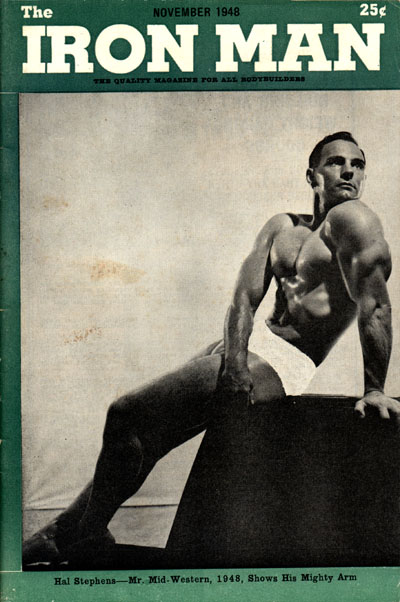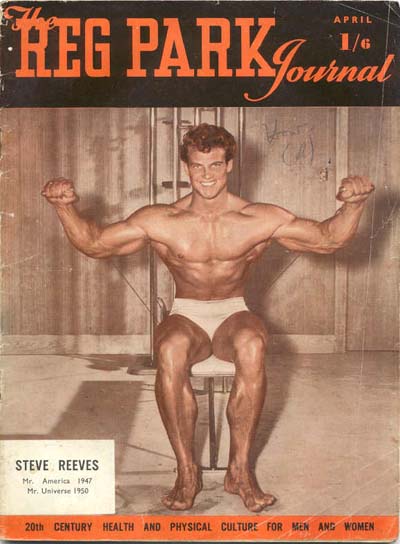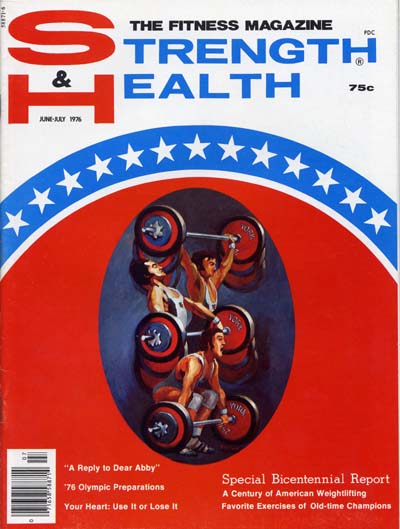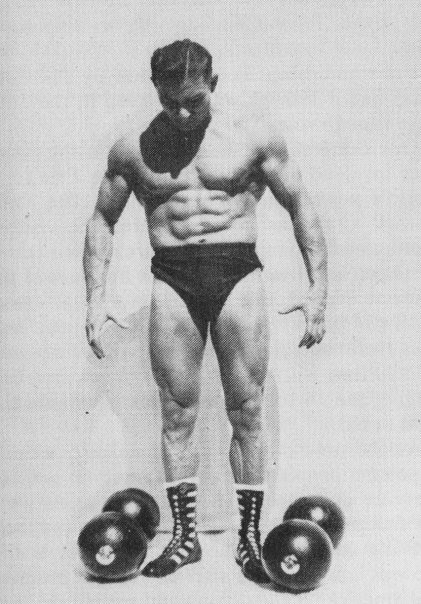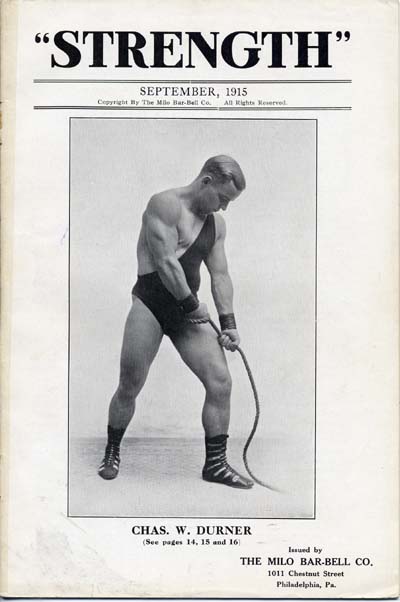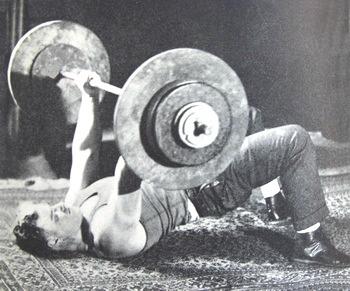Click Pic to ENLARGE
Top photo taken at Doug Hepburn's Grandview Barbell Club.
Article From "Iron Man Lifting News" December 1954
from Liam Tweed's Collection.
Due to the space taken by the World Championships report in our last issue we were forced to leave out our installment on developing the press. However, we are happy to be able to dontinue with it in this issue. We closed the September article with a description of the rules as found in our present rule book. If you don't have the issue either get one or get out your rule book for we wish to make a few comments on those rules.
The description of the first movement of the press is OK as far as it goes. We don't always observe these rules even then because we have often seen men with their feet spread much farther apart than 16 inches mentioned, especially tall men with rather long legs. Either we should leave this item out or it should be enforced.
In the second movement we find it mentions the pause at the shoulders for two seconds and then press after the referee claps his hands. Quite often this hand clap is hard for the lifter to hear and I used to find it better to say "press" when it was time for him to lift. In addition to being more distinct and less likely to be confused with noise from the audience, it also has a psychological value as an order to perform a movement. Many referees give the clap or signal too soon - even before the lifter has stopped moving around with his feet. This is, of course, very wrong. While I can see no reason for making a lifter stand still for any longer period than is necessary for him to assume the correct position, still some officials require the lifter to stand there holding the weight for a long time. So we feel that the official should give the signal as soon as the lifter assumes the correct position and stops moving around.
I guess we used to do things differently years ago. When a lifter finished his lift, instead of clapping the hands we counted one, two, and on the count of two the lifter lowered the bell. Anyhow, here is another spot where the officials sometimes get excited and give the signal to lower the weight too soon. Be sure that the lifter has finished the press correctly and holds the weight in a stationary position for two seconds to indicate he has complete control. Hasty signals are more frequent in the snatch and clean and jerk than in the press, for most men who can press a weight have the power to control it for two seconds after the lift is finished. Occasionally a man will lose his balance and raise the toes or take a step if he has to hold it too long, but this would indicate a lack of control of the weight. Regardless of this, if he can hold it for two seconds without any of these things happening, the rules say it is a good lift.
It also states that the lifter should keep the body and head in a vertical position at all times during the press - Wow! We sure get off the beam here, don't we? Many men, when starting the press, and just after cleaning, will assume a decided back bend as certain Russian lifters have been in the habit of doing. They they will press from this position very rapidly. Now, either we should re-write the rules or make the lifters follow them as they are written. Such a starting back-bend gives the lifter a decided advantage. It amounts to a modified Continental press. In this position you are able to bring the pectoral muscles very strongly into play and increase your press a great deal. A man lifting in erect style against a fellow who uses this position is at a decided disadvantage. Still the judges pass such lifts and so you can hardly blame the lifters for using them. It is especially prevalent in certain international contests. Generally, too much back bend is not allowed in major contests in the USA, though, of course, there are exceptions.
Others will give a fast start by leaning forward then back into a back bend, which also violates the rules. You will also note that the rules say the head must remain vertical. That means you should look straight ahead. Only a few lifters today observe this rule. Heel lift and toe raise, for some reason or other, is a point on which officials are very strict. Lifters seldom get away with this but they let other more serious things pass without a thought.
I have seen some men get a leg thrust, even though small, on every lift they make and get away with it for years, even on world records. Others get a shoulder hunch in the start of the lift and get away with it while still others use what is termed a body surge and never get ruled out. These things must be watched.
Uneven pressing out of the arms is another point on which the judges are fairly strict. So we can see that in general the rules written and the rules used do not harmonize in very many respects.
Regardless of what the rules happen to be, the lifter should be prepared to lift however the officials require. Before every contest there should be a briefing of the men as to what the rules will be. If a man has been accustomed to lifting in a sloppy manner he should be able to at any time adapt himself to the strictest kind of ruling. He must know what he can lift in this stricter style or he will find himself without a press or total. We have seen many men miss their presses altogether because they were not able to select proper poundages for stricter styles required in certain contests.
There are a lot of people who will tell you that the press is strictly a power lift and that is all you need. However, this is not strictly true, for you can introduce a lot of science into this lift. Let's start at the first of the lift and study the different points and discuss the best method for performing the press before we go on to the power developing part.
Very few men will have trouble with the clean or pull to the shoulders. There are a few notable exceptions, of course, such as Doug Hepburn, who can press about 70 or 80 pounds more than he can clean, or DePietro who has trouble cleaning his presses.
You will do a much better press if you do an easy clean. To this end we suggest that when you pull the clean in, you do so with all the power and speed possible. Don't squat or split any more than necessary. this will save you strength and give you a much better position to press from. A hard clean means you will be pulled down and tired for the press. An easy fast clean will give you confidence, a feeling of power and a good solid position to press from.
You should clean with the grip you expect to press with, that is, if you are going to use a wide grip then you should clean with a wide grip. If you are going to press with a thumbless grip then try to clean with a thumbless grip, though if you lack gripping power you can do as some fellows do and clean with a hook grip then change to the thumbless grip as the bar reaches the shoulders. By thumbless grip we mean with the thumbs under the bar and on the same side as the fingers. The reason for this is the theory that a thumbs-around grip causes tension on certain arm muscles which throws an opposing force against the pressing muscles and thereby cuts down your pressing power. Though this has never been definitely proven by any scientific means, enough lifters have experimented with it and concluded they can press more with a thumbless grip to make it worth of their consideration. Try it anyhow and see what you think. At first it may seem a little awkward but you may grow to like it. Many lifters use it for their jerks as well.
Before we go any farther we should consider the width of the grip since you should select your hand spacing very carefully before cleaning the bar. Most lifters will use some method of measuring out from the collars, usually so many hand widths from each collar. Others will use the knurling as a gauge. However, the latter is not always accurate, since the knurling may vary in width on different bars. It may surprise some lifters, but a difference of an inch can make a great deal of difference in a lift. This is especially true if you have one hand a half inch or an inch closer to the collars than the other hand for it can throw considerable more weight on one arm on the other and perhaps cause you to fail to press it. If you have one arm that is a little weaker than the other, you can learn to compensate for this by bringing the weak hand a half inch or so (depending on how much weaker it is) closer to the collar. This will throw less weight on this arm and more on the stronger arm and thus allow you to press out evenly with both arms.
Whilewe are talking about width of grip we'd like you to get out your back issues of Lifting News and Iron Man and observe the grip widths used by different lifters. You will see that most of them use a grip that is just a little wider than shoulder width (depending on how wide you think your shoulders are - I guess some fellows might place their hands against the collars).
In the November issue of Lifting News on page 1 you will see Kono pressing. Tommy holds the world middleweight record in the press now at 286.5, having made it in France before returning from the World Championships.
Click Pic to ENLARGE
The photo shows him using fine style as it is known today. Although his feet may be a little wider than 16 inches apart, he has very little, if any, back bend. Also, he is looking straight ahead. This photo, taken from a low angle, might make it appear as if he is leaping back but this is not true. You will note he is using a thumbs-around grip - in fact it appears that he even has a hook grip in which the fingers cover the thumbs for a more secure grip in cleaning. His grip width would be considered medium and as you can see, it is about 2 inches outside the inside edge of the knurling. His thumbs would probably come just outside his shoulder points when bar is at shoulders.
On page 5 of the November issue Lomakin of Russia is pressing with the same width grip, possibly a little wider. You will note that he is looking up or rather his head is tipped back, which is a violation of the rules, yet the judges thought this a very good press. Notice also that those men with deep chests can arch the chests and place the pectoral muscles in a very active position to aid with the press. You can see this in many photos. Other fellows with comparatively flat chests, like Schemansky, can get very little help this way unless they lean back a lot. You can see what we mean on page 8 of the July issue. In this same issue, take a look at Hepburn pressing on page 9. You can see that he is using a wider grip than most of the other fellows. Davis has a medium grip though a few years ago he used a very narrow grip, about 14 inches, I would judge. This was especially noticeable at his contest with Abele and Stanko. However, it worked very well for him. It did seem to require more back bend than pressing with a wider grip, though. At that time I believe he was pressing around 325, which was very good. Pressing with a narrow grip enables you to use the triceps more while the use of a wide grip brings the deltoids more into action.
Of course the use of a wide grip means you have less distance to press, but, on the other hand a wide grip makes it difficult to get a fast start because you don't have the initial arm drive that you do with a closer grip.
A few years ago we heard a great deal about pressing leverages and if a man was a poor presser he blamed it on bad leverages. Today we hear less about this and I believe most lifters have found that so-called bad leverages can be at least partially compensated for by a change in style and special development exercises. We don't have nearly as many really poor pressers now as we had a few years ago. In those days it was felt that if you had long arms you couldn't press. Some of our good pressers today have fairly long arms however.
We must not lose sight of the fact that long arms are somewhat of a handicap, though, and must be adjusted for by a change of style and specialization work.
Some of the paper experts claim that a good presser should have long upper arms and short forearms. This depends on your style of pressing. A man with short forearms may find that he can press better by starting with his elbows high and keeping them that way all through the press and thus taking advantage of his advantageous leverage of the short forearms.
On the other hand a man with long forearms and short upper arms may find it better to press with the elbows starting low and driving straight up with deltoid power.
Again, we may find that our calculations arrived at through examinations of relative bone lengths may be upset because of differences of muscle attachments. Let us illustrate what we mean by using the curl as an example Have you ever noticed that the best curlers are the men who have muscle attachments far out on the forearm at the lower end of the biceps muscle? A still more outstanding illustration would be the reverse curl. Watch different men curl and you will notice that the best men at this feat have forearm muscles that are attached high up on the upper arm bone. This gives them greater curling ability for a given amount of contractile power of the muscles.
The same thing is evident in the press, though the illustration would be much more complicated because so many muscles and groups of muscles are involved. We feel that this muscle attachment is of much greater importance than bone lengths, not because relative bone lengths are not important, but because we have found more frequent variations in muscle attachments making the difference between a poor presser and a good presser. This condition of course exists throughout the entire body. This partly explains why the strongest men are seldom the best built. A man with the best muscle attachments for power does not have the small, compact joint areas for the greatest physical shape. Of course there are occasional exceptions to this rule.
Of course the use of a wide grip means you have less distance to press, but, on the other hand a wide grip makes it difficult to get a fast start because you don't have the initial arm drive that you do with a closer grip.
A few years ago we heard a great deal about pressing leverages and if a man was a poor presser he blamed it on bad leverages. Today we hear less about this and I believe most lifters have found that so-called bad leverages can be at least partially compensated for by a change in style and special development exercises. We don't have nearly as many really poor pressers now as we had a few years ago. In those days it was felt that if you had long arms you couldn't press. Some of our good pressers today have fairly long arms however.
We must not lose sight of the fact that long arms are somewhat of a handicap, though, and must be adjusted for by a change of style and specialization work.
Some of the paper experts claim that a good presser should have long upper arms and short forearms. This depends on your style of pressing. A man with short forearms may find that he can press better by starting with his elbows high and keeping them that way all through the press and thus taking advantage of his advantageous leverage of the short forearms.
On the other hand a man with long forearms and short upper arms may find it better to press with the elbows starting low and driving straight up with deltoid power.
Again, we may find that our calculations arrived at through examinations of relative bone lengths may be upset because of differences of muscle attachments. Let us illustrate what we mean by using the curl as an example Have you ever noticed that the best curlers are the men who have muscle attachments far out on the forearm at the lower end of the biceps muscle? A still more outstanding illustration would be the reverse curl. Watch different men curl and you will notice that the best men at this feat have forearm muscles that are attached high up on the upper arm bone. This gives them greater curling ability for a given amount of contractile power of the muscles.
The same thing is evident in the press, though the illustration would be much more complicated because so many muscles and groups of muscles are involved. We feel that this muscle attachment is of much greater importance than bone lengths, not because relative bone lengths are not important, but because we have found more frequent variations in muscle attachments making the difference between a poor presser and a good presser. This condition of course exists throughout the entire body. This partly explains why the strongest men are seldom the best built. A man with the best muscle attachments for power does not have the small, compact joint areas for the greatest physical shape. Of course there are occasional exceptions to this rule.


.jpg)













